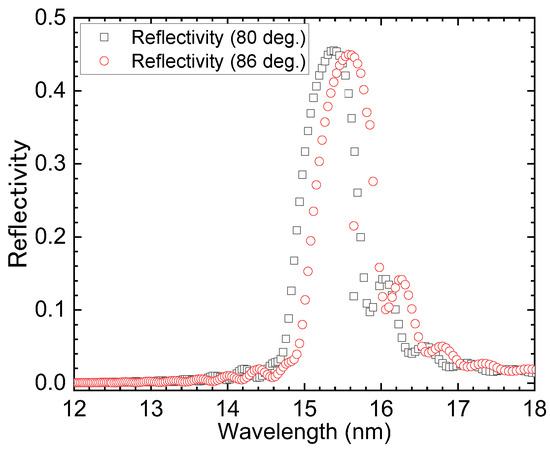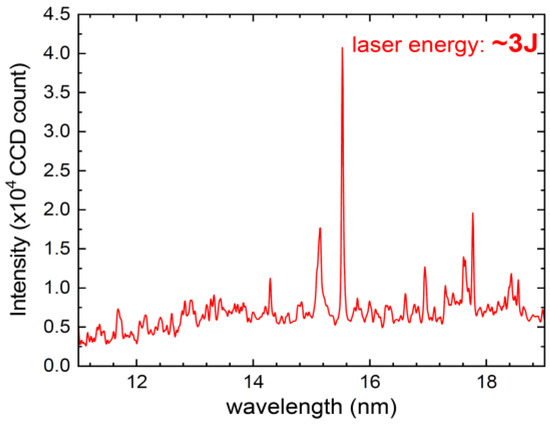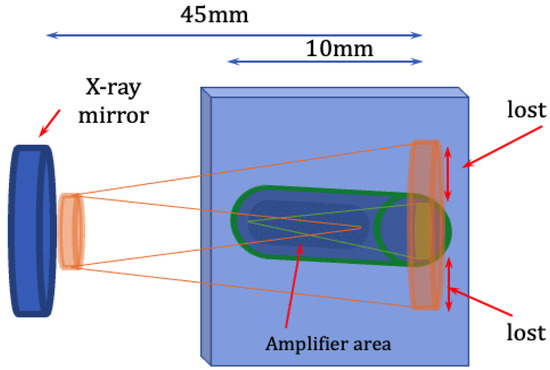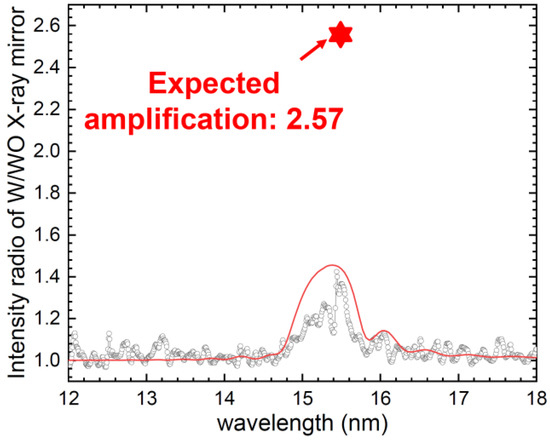Abstract
A recombination plasma soft X-ray laser that is associated with Li-like Aluminum ion Al10+ 3d-4f transition (wavelength: 15.47 nm) was investigated to increase the gain coefficient. By optimizing the time interval of the 16-pulse train, higher-density plasma with a low temperature could be generated, and thus, we obtained the gain coefficient of 9.84 cm−1 at the pump laser pulse energy which was as low as 3 J. To further enhance the X-ray laser output energy, the single resonator which was installed by using a Mo/Si multilayer mirror that has a high reflectivity of 0.45 at 15.5 nm, and the X-ray spectrum after the double pass in the lasing medium was measured. As a result, the output intensity was increased to be 1.5 times higher than t=when it was compared with those that were conducted with no X-ray mirror.
1. Introduction
Plasma X-ray lasers have been given attention in scientific and engineering fields [1,2,3,4], including X-ray microscopy [5], X-ray photoelectron spectroscopy [6], X-ray lithography [7], and X-ray holography [8]. For the generation of a population inversion to achieve laser oscillation, two pumping schemes have been proposed and demonstrated in terms of lasing actions so far, and these are the collisional electron excitation scheme [9,10,11] and the recombination plasma scheme [12,13]. Since the plasma-excited X-ray laser is driven by the amplified spontaneous emission (ASE) phenomenon of highly charged ions that are created in the laser-produced plasmas, a driver laser facility with very high output pulse energy was indispensable in the experiments of the 1980’s. Thus, considerable improvements to the pump laser energy are necessary to realize a practical X-ray laser, which would enable us to operate and maintain a compact and high-repetition X-ray laser. The progress in the smaller sized lasers has been made by the innovation of the chirped-pulse-amplification (CPA) [14].
In a transient collisional excitation scheme, a weak pre-laser pulse produces an initial transient plasma, in which the highly charged ions are pumped in a neon-like or a nickel-like ion ground state, and subsequently, an intense main laser pulse heats the pre-plasma, thereby resulting in the creation of population inversion even with a small laser energy level [15,16]. As for the recombination plasma scheme, a relatively light element is employed. The resultant high-temperature and high-density plasma that is generated experiences the rapid cooling of it due to an adiabatic expansion in the vacuum, and then, a non-equilibrium plasma with a high density and a low temperature is created, where a three-body recombination process dominates over the other reactions. Subsequently, the electrons that are captured at the high Rydberg levels decay into the lower excited states through the ladder-like collisional de-excitation, while the population of the lower excited states suffers from fast radiative decay, thereby terminating into the ground state (resonance transition). As a result, the population inversion that occurs between certain lower levels is created. The first demonstration of the recombination plasma X-ray laser was performed by Suckewer et al., and they succeeded in lasing an H-like C n = 3→2 transition (18.2 nm) [12]. In addition, the CPA shorter laser pulse technique for plasma generation was utilized for the efficient recombination plasma X-ray laser.
To decrease the laser pulses energy significantly, the method by means of a pulse train laser irradiation was proposed, in which the successive laser pulses are efficiently absorbed in the preformed plasma, and highly charged ions are generated even with a joule class laser [17,18]. In fact, the ASE soft X-ray of the Li-like Al 3d-4f transition (15.5 nm) was demonstrated by irradiating the 16-pulse train that each have a pulse duration of 100 ps and intervals of 200 ps onto an Al target [19], and an X-ray gain coefficient of 8.3 cm−1 [20] has been achieved so far.
In this study, we have tried to enhance the X-ray laser intensity by using a single resonator that has an X-ray mirror. The Mo/Si multilayer mirror has a high reflectivity for an X-ray laser wavelength of 15.5 nm, and the resultant double pass X-ray laser energy increases exponentially along the lasing medium.
2. Experimental Setup
In the experiment, a mode-locked 1064-nm, 100-MHz Nd:YAG oscillator (pulse duration of 100 ps) was used as a seeded laser pulse, and it was amplified in a regenerative amplifier using the 10-Hz operation mode. The laser beam of a few Mj was divided into an 8-pulse train that had time intervals between pulses of 250 ps by an optical stacker and a delay line component. The total pulse energy of up to 3 J was irradiated onto an Al slab target. The pulse train laser irradiation efficiently created highly charged ions that were up to He-like Al ion through continuous electron heating [20], and the plasma temperature dropped immediately after the laser irradiation. As a result, the pulse-train method provides a favorable lasing condition to create the population inversion, owing to the three-body collisional recombination and subsequent ladder-like de-excitation which occur. The Al line shaped plasma was generated by focusing the YAG laser beam by utilizing a prism lens array. The focus size having a homogeneous intensity distribution was 50 μm and up to 12 mm in height and length, respectively [20]. Soft X-ray spectra were collected using a toroidal mirror and focused onto an entrance slit of a grazing incident spectrometer (flat-field, 1200 grooves/mm) that was equipped with a back-illuminated CCD camera.
By varying the plasma length (lasing medium), we evaluated the gain coefficient for Li-like Al ion 3d-4f transition. On the other hand, the Mo/Si mirror was installed 20 mm away from the target edge. X-ray laser was radiated into both target sides, and one of them was reflected by this Mo/Si multilayer mirror, and subsequently, it was returned to the lasing medium, resulting in increase of the X-ray intensity significantly due to the double pass effect (single resonator), as shown in Figure 1. Figure 2 shows the reflectivity of the X-ray mirror around 15.5 nm for two incident angles with respect to the target surface. At around a 15.5 nm wavelength, the reflectivity was as high as 0.45. The reflected laser beam had to return to the lasing medium area precisely, as shown in Figure 1a. To this end, a HeNe laser incident from the CCD side of the spectrometer traced the X-ray laser traveling axis, in which the HeNe laser passed through the exit slit, toroidal mirror, target surface and X-ray mirror. We aligned the optics for the round-trip laser beam to return to the initial position of the HeNe laser.

Figure 1.
(a) Schematic of single resonator for 15.5 nm Li-like Al X-ray laser. (b) Photograph of the experimental setup for the double pass amplification.

Figure 2.
Reflectivity of the Mo/Si multilayer concave mirror for two incident angles.
3. Results and Discussion
Figure 3 shows the typical X-ray lasing spectrum for the 15.5 nm Li-like Al 3d-4f transition. The plasma length, L, was 12 mm, and the total laser pulse energy was about 3 J. By varying the incident laser length from 0.5 mm to 12 mm, we could evaluate the gain coefficient, g. When the plasma lengths were below L = 3 mm, the spectral intensity increased exponentially. The exponential fitting of the CCD count yielded the gain coefficient of g = 9.84/cm. On the other hand, when it was over 3 mm in length, the intensity increased linearly in terms of the length of lasing medium, implying that the amplification is likely to be classified into a gain saturation regime.

Figure 3.
Lasing spectrum of 15.5 nm Li-like Al ion 3d-4f trainstion.
To further increase the X-ray laser output energy, we conducted the experiment by using the single resonator. The expected increase in the CCD count, ICCD, can be evaluated by the following equation,
where I1 is the CCD count of X-ray laser intensity from each target side, is the coupling efficiency, and R is the reflectivity of the X-ray mirror. The coupling efficiency was defined by the ratio of the divergence area between the initial amplified laser and the reflected amplified laser, as shown in Figure 4. By substituting the values of = 0.00123, R = 0.45, g = 9.84 and L = 12 mm, we obtained .

Figure 4.
Schematic of the explanation of the coupling coefficient. The geometory of the target and X-ray mirror is also shown.
Figure 5 plots the intensity ratio of studies with and without X-ray mirror. The solid line corresponds to the fitting curve of the experimental data according to the mirror reflectivity. The CCD count of the 15.5 nm X-ray laser was increased by only 1.5 times with the X-ray mirror, although the geometrical estimation and mirror reflectively expected the value of 2.57 times, as indicated in the figure. The reason for this could be explained by there being an insufficient alignment of the reflected X-ray beam. The X-ray mirror holder for the laser beam had only one set of vertical and horizontal steering nobs, although we needed two sets for a precise alignment to be performed. Consequently, the reflected laser did not pass through the lasing plasma medium appropriately and it was blocked by some apertures that settled to avoid the stray light. Further, the precise alignment by using two mirror holders is necessary to solve this problem.

Figure 5.
Improvement of the gain coefficient by means of the single resonator. The values expected from the coupling efficiency, mirror reflectivity, and gain and the fitting curve of the experimental data based on the mirror reflectivity are also plotted.
4. Summary
We have tried to increase the gain coefficient of a soft X-ray laser that is associated with a 15.5 nm Li-like Al 3d-4f transition in laser-produced recombining plasmas. By changing the time interval of the 16-pulse train, we controlled the property of the laser plasma and optimized the gain coefficient of 15.5 nm X-ray laser. As a result, the gain coefficient reached 9.84/cm. On the other hand, for the further enhancement of the laser output energy, we have employed the single resonator method. The CCD count which was measured using the X-ray mirror was by 1.5 times higher than the value that was obtained without the mirror, although the higher value of 2.57 that was expected from the experimental geometry and gain was obtained.
Author Contributions
Conceptualization, S.N., T.H., M.N.; methodology, S.N., J.Z., M.K., N.H.; investigation: J.W., H.O., J.Z., M.K., K.Y., N.H., T.D., M.I.; data curation, S.N., H.O., J.Z.; writing—review and editing, S.N., J.W., M.K.; funding acquisition, S.N. All authors have read and agreed to the published version of the manuscript.
Funding
This research was supported by JSPS KAKENHI under Grant No. JP20H00141, JKA Foundation (KEIRIN RACE).
Data Availability Statement
Not applicable.
Conflicts of Interest
The authors declare no conflict of interest.
References
- Elton, R.C. X-ray Lasers; Academic Press: London, UK, 1990. [Google Scholar]
- Attwood, D. Soft-X-rays and Extreme Ultraviolet Radiation: Principles and Applications; Cambridge University Press: Cambridge, UK, 2000. [Google Scholar]
- Daido, H. Review of soft X-ray laser researches and developments. Rep. Prog. Phys. 2002, 65, 1513. [Google Scholar] [CrossRef]
- Suckewer, S.; Jaegle, P. X-ray laser: Past, present, and future. Laser Phys. Lett. 2009, 6, 411. [Google Scholar] [CrossRef]
- DiCicco, L.D.; Skinner, H.; Suckewer, S.; Hirschberg, J.; Kohen, E. X-ray Microscope II; Syre, D., Howells, M., Kirz, J., Rarbackd, H., Eds.; Springer: Berlin/Heidelberg, Germany, 1988; pp. 46–49. [Google Scholar] [CrossRef]
- Namba, S.; Hasegawa, N.; Nishikino, M.; Kawachi, T.; Kishimoto, M.; Sukegawa, K.; Tanaka, M.; Ochi, Y.; Takiyama, K.; Nagashima, K. Enhancement of Double Auger Decay Probability in Xenon Clusters Irradiated with a Soft-X-ray Laser Pulse. Phys. Rev. Lett. 2007, 99, 043004. [Google Scholar] [CrossRef] [PubMed]
- Marconi, M.C.; Wachulak, P.W.; Urbanski, L.; Isoyan, A.; Jiang, F.; Cheng, Y.C.; Rocca, J.J.; Menoni, C.S.; Cerrina, F. Tabletop soft X-ray lithography. Proc. SPIE 2007, 7451, 74510J. [Google Scholar] [CrossRef]
- Trebes, J.E.; Brown, S.B.; Campbell, E.M.; Matthews, D.L.; Nilson, D.G.; Stone, G.F.; Whelan, D.A. Demonstration of X-ray Holography with an X-ray Laser. Science 1987, 238, 517. [Google Scholar] [CrossRef] [PubMed]
- Zherikhin, A.; Koshelev, K.; Letokhov, V. Gain in the far vacuum ultraviolet region due to transitions in multiply charged ions. Sov. J. Quant. Mech. 1976, 6, 82. [Google Scholar] [CrossRef]
- Vinagradov, A.V.; Shlyaptsev, V. Amplification of ultraviolet radiation in a laser plasma. Sov. J. Quantum Electron. 1983, 13, 1511. [Google Scholar] [CrossRef]
- Matthews, D.L.; Hagelstein, P.L.; Rosen, M.D.; Eckart, M.J.; Ceglio, M.N.; Hazi, A.U.; Medecki, H.; MacGowan, B.J.; Trebes, J.E.; Whitten, B.L.; et al. Demonstration of a Soft X-ray Amplifier. Phys. Rev. Lett. 1985, 54, 110–113. [Google Scholar] [CrossRef] [PubMed]
- Suckewer, S.; Skinner, C.H.; Milchberg, H.; Keane, C.; Voorhees, D. Amplification of stimulated soft X-ray emission in a confined plasma column. Phys. Rev. Lett. 1985, 55, 1753. [Google Scholar] [CrossRef] [PubMed]
- Zhang, J.; Key, M.H.; Norreys, P.A.; Tallents, G.J.; Behjat, A.; Danson, C.; Demir, A.; Dwivedi, L.; Holden, M.; Holden, P.B.; et al. Demonstration of high gain in a recombination XUV laser at 18.2 nm driven by a 20 J, 2 ps glass laser. Phys. Rev. Lett. 1995, 74, 1335–1338. [Google Scholar] [CrossRef] [PubMed]
- Strickland, D.; Mourou, G. Compression of amplified chirped optical pulses. Opt. Commun. 1985, 56, 219–221. [Google Scholar] [CrossRef]
- Nickles, P.V.; Shlyaptsev, V.N.; Kalachnikov, M.; Schnúrer, M.; Will, L.; Sandner, W. Short Pulse X-ray Laser at 32.6 nm Based on Transient Gain in Ne-like Titanium. Phys. Rev. Lett. 1997, 78, 2748–2751. [Google Scholar] [CrossRef]
- Dunn, J.; Osterheld, A.L.; Shepherd, R.; White, W.E.; Shlyaptsev, V.N.; Stewart, R.E. Demonstration of X-ray Amplification in Transient Gain Nickel-like Palladium Scheme. Phys. Rev. Lett. 1998, 80, 2825–2828. [Google Scholar] [CrossRef]
- Hara, T.; Ando, K.; Aoyagi, Y.; Kusakabe, N.; Yashiro, H. Soft X-ray Lasing in an Al Plasma Produced by a 6 J Laser. Jpn. J. Appl. Phys. 1993, 28, L1010. [Google Scholar] [CrossRef]
- Hirose, H.; Hara, T.; Ando, K.; Negishi, F.; Aoyagi, Y. Enhancement of Soft X-ray Emission from Al Plasma by Pulse Train Laser Irradiation. Jpn. J. Appl. Phys. 1993, 32, L1538–L1541. [Google Scholar] [CrossRef]
- Yamaguchi, N.; Fujikawa, C.; Ohchi, T.; Hara, T. Dotted-array plasma production bu using a line focusing lens system with segmented prism array for compact X-ray laser experiments. Jpn. J. Appl. Phys. 2000, 39, 5268. [Google Scholar] [CrossRef]
- Namba, S.; John, C.; Morishita, T.; Kubo, N.; Kishimoto, M.; Hasegawa, N.; Nishikino, M. Observation of gain coefficients of 15.47 nm Li-like Al soft X-ray laser in a recombining plasma pumped by a compact YAG laser. High Energy Density Phys. 2020, 25, 100790. [Google Scholar] [CrossRef]
Publisher’s Note: MDPI stays neutral with regard to jurisdictional claims in published maps and institutional affiliations. |
© 2022 by the authors. Licensee MDPI, Basel, Switzerland. This article is an open access article distributed under the terms and conditions of the Creative Commons Attribution (CC BY) license (https://creativecommons.org/licenses/by/4.0/).